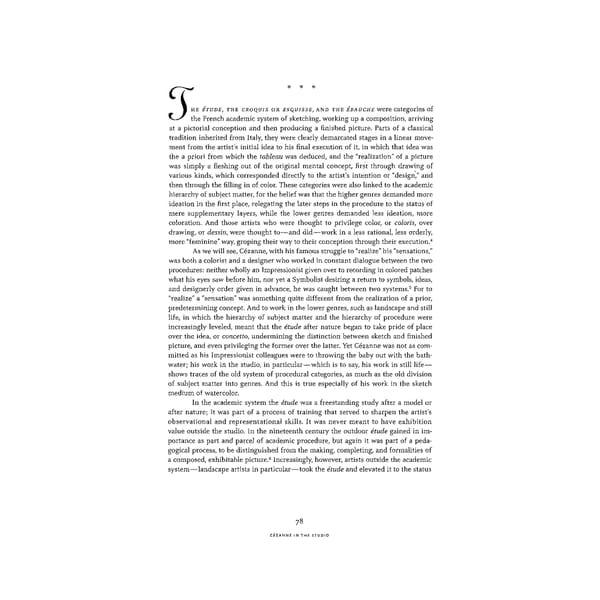HE ÉTUDE, THE CROQUIS OR ESQUISSE, AND THE ÉBA UCHE Were Categories of j the French academic system of sketching, working up a composition, arriving at a pictorial conception and then producing a finished picture. Parts of a classical tradition inherited from Italy, they were clearly demarcated stages in a linear move- ment from the artist's initial idea to his final execution of it, in which that idea was the a priori from which the tableau was deduced, and the "realization" of a picture was simply a fleshing out of the original mental concept, first through drawing of various kinds, which corresponded directly to the artist's intention or "design," and then through the filling in of color. These categories were also linked to the academic hierarchy of subject matter, for the belief was that the higher genres demanded more ideation in the first place, relegating the later steps in the procedure to the status of mere supplementary layers, while the lower genres demanded less ideation, more coloration. And those artists who were thought to privilege color, or coloris, over drawing, or dessin, were thought to—and did—work in a less rational, less orderly, more "feminine" way, groping their way to their conception through their execution.4 As we will see, Cézanne, with his famous struggle to "realize" his "sensations," was both a colorist and a designer who worked in constant dialogue between the two procedures: neither wholly an Impressionist given over to recording in colored patches what his eyes saw before him, nor yet a Symbolist desiring a return to symbols, ideas, and designerly order given in advance, he was caught between two systems.5 For to "realize" a "sensation" was something quite different from the realization of a prior, predetermining concept. And to work in the lower genres, such as landscape and still life, in which the hierarchy of subject matter and the hierarchy of procedure were increasingly leveled, meant that the étude after nature began to take pride of place over the idea, or concetto, undermining the distinction between sketch and finished picture, and even privileging the former over the latter. Yet Cézanne was not as com- mitted as his Impressionist colleagues were to throwing the baby out with the bath- water; his work in the studio, in particular—which is to say, his work in still life— shows traces of the old system of procedural categories, as much as the old division of subject matter into genres. And this is true especially of his work in the sketch medium of watercolor. In the academic system the étude was a freestanding study after a model or after nature; it was part of a process of training that served to sharpen the artist's observational and representational skills. It was never meant to have exhibition value outside the studio. In the nineteenth century the outdoor étude gained in im- portance as part and parcel of academic procedure, but again it was part of a peda- gogical process, to be distinguished from the making, completing, and formalities of a composed, exhibitable picture.6 Increasingly, however, artists outside the academic system—landscape artists in particular—took the étude and elevated it to the status 78 CÉZANNE IN THE STUDIO
 Cézanne in the Studio: Still Life in Watercolors Page 92 Page 94
Cézanne in the Studio: Still Life in Watercolors Page 92 Page 94